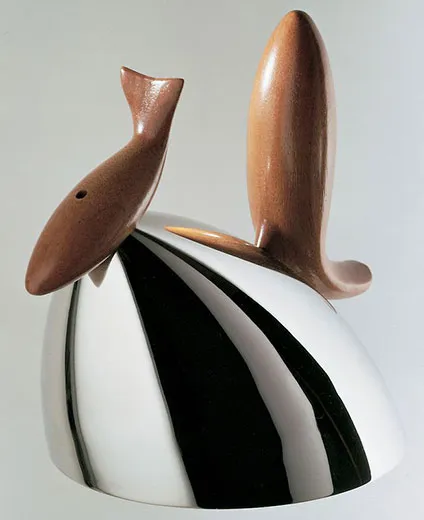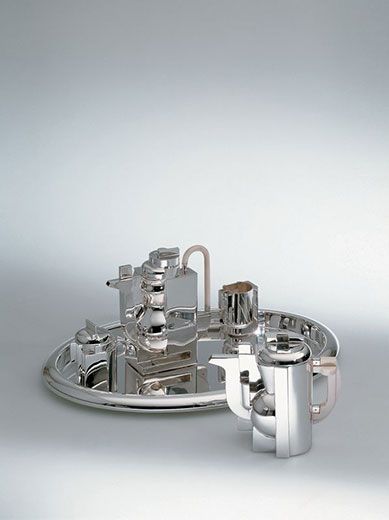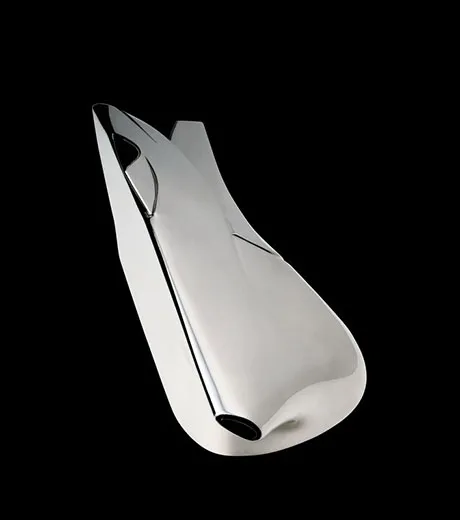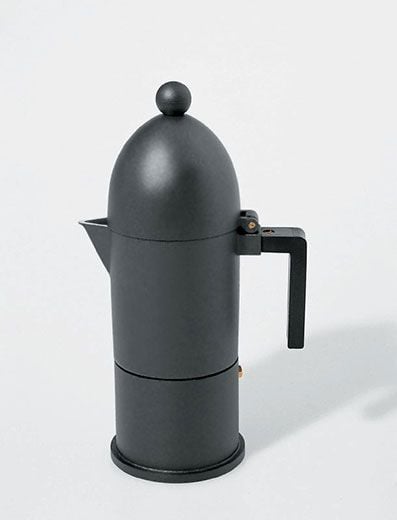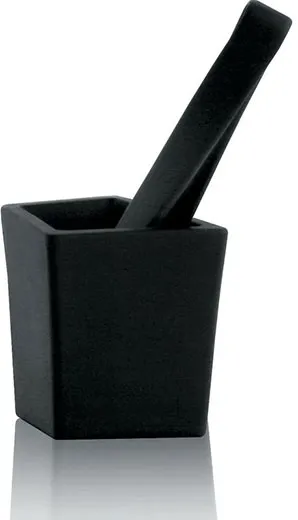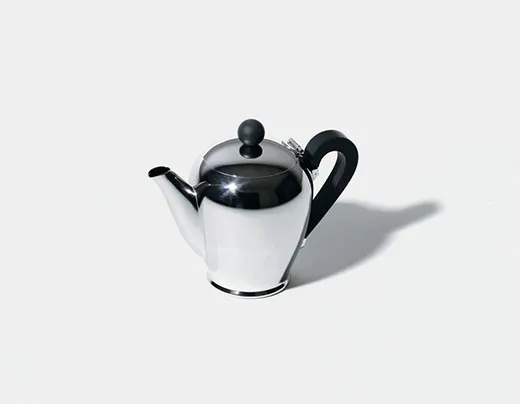Inside the World of Alessi
Hidden away in northern Italy’s lake district, the design factory has influenced the look of American kitchens for decades
/https://tf-cmsv2-smithsonianmag-media.s3.amazonaws.com/filer/Alessi-Michael-Graves-tea-kettle-631.jpg)
Tiny, little-known Lago d'Orta—just a mile wide, it lies to the west of Maggiore—is a sleepy European summertime destination, its forested shores peppered with stone-walled medieval villages. But hidden away at the northern end of the lake, above the town of Omegna and its gritty industrial zone, is a temple to modern international design: the Alessi factory.
In 1921, a skilled metalsmith named Giovanni Alessi set up shop here, in an area with a long history of quality wood and metal handicraft. Throughout the 1920s and ’30s, the family workshop turned out traditional items for the table and home—coffeepots, bowls, trays, tongs—in copper, brass, and nickel silver.
In the decades since, the company "lab" has married these traditions with forward-thinking ideas, in collaborations with hundreds of international independent designers. Even the most casual observer of housewares will recognize familiar items from the Alessi catalog: an early and classic coffee-shop creamer; a corkscrew with a cutout face, by Alessandro Mendini; a spidery lemon squeezer, by Philippe Starck; a pair of playful salt and pepper shakers with magnetized feet, by Stefano Giovannoni.
Alessi doesn't employ in-house designers, preferring that its creative partners have minds that stay "free.” Scion Alberto Alessi—the grandson of Giovanni, he is the third generation to join the family business—says this is in keeping with “a long chain” of Italian industrial design tradition. What the company does have is an in-house dream team of technical engineers, each specializing in a particular material, who help bring the designs to physical reality.
In the heat of Italian summer, I made a pilgrimage to the factory to find out a bit more of the backstory from Alberto Alessi himself, and from the factory and museum’s historic archive of archetypal housewares. A giant model of the famous Bombé teapot, designed by Alberto’s father, Carlo, in 1945, marks the turnoff from the road. This is the only place where you can view the complete range of the company’s products—many of which reside in the permanent collections at the Museum of Modern Art in New York, Centre Pompidou, the Victoria & Albert Museum, the Smithsonian Institution and the Metropolitan Museum of Art—and purchase from the entire current catalog, on display in the enormous factory shop.
“Our job is to be a mediator between the best expressions of creativity and product design and people’s dreams,” Alberto tells me during a chat in his cool, dim office, its long tables cluttered with books and papers and prototypes sent to him from aspiring designers. “That’s why I use the term ‘dream factory’ to talk about what we do.” When Alberto came to the company in the summer of 1970, he became interested in the relationship between people and objects—and in the creation of functional pieces with a point of view, appealing in other, more profound senses than functionality.
Many Alessi products are creations of top American designers. The whimsical Alessi bird whistle tea kettle, designed by architect Michael Graves in 1985, is the company's best-selling item of all time. But when Alessi first approached Graves in 1979, he was a well-known architect who had never before done product design.
The company invited a number of notable architects to work on a brainstorming project called the “Tea and Coffee Piazza”: examining the classic pieces of the coffee and tea service—the teapot, coffeepot, sugar bowl, tray and creamer—as a kind of town square, with the pieces as architectural elements. As a result, 11 limited-edition silver services were produced under the Officina Alessi brand, each bearing the designer’s monogram. The project earned Alessi a new respect in the design world, and two of those architects—Graves and Aldo Rossi—were key design discoveries for Alessi, going on to create iconic kettles, coffee presses and many other items.
The best designers in history, Alberto tells me, have always been architects. Graves, of course, is now a home design authority with a line for Target and countless products for Alessi. Alberto explains that the Alessi method of external collaboration is nothing new—“it’s how Italian design factories have worked for many decades”—but he believes that it is a manner of working that has been lost in today’s industrial design world.
“The door of industry, unfortunately, is now more closed than it was,” Alberto says. “We still try to be a kind of research workshop in the field of applied arts, open to many different influences and collaborations. But we are the last link in a long chain.”
Frank Gehry, Richard Meier and Morphosis studio are all key American design figures who have collaborated with Alessi; of course, non-Americans like Aldo Rossi have also shaped contemporary design through their work for Alessi (Rossi's conical coffee maker was a design stamp of the 1980s). Alessi conducts four to five workshops a year with schools, and recently concluded a project with Michigan’s Cranbrook Academy of Art. Five metalsmithing products from young designers were selected for manufacture in the coming year. “We chose a perforated basket, a flower vase, a fruit holder, a cake stand, and a banana holder.” He pauses, looking quizzical. “There were a lot of students who chose to make banana holders. I think the banana holder must be a very American thing?”
Though there might not be any banana holders yet in the Alessi oeuvre on display at the Museo Alessi, there seems to be just about everything else. Curator Francesca Appiani and team oversee all aspects of the museum, including its collection of prototypes, back-cataloged products and rare graphic pieces that recount the history of Alessi’s cultural identity; Appiani also organizes exhibitions, publications and visits by appointment. The collection is a cross-section of design over the years: a buoyant, eclectic visual history of how the design company and its global collaborators have imagined life in the home. In a testament to its continuing influence, Alessi has pieces in more permanent museum collections than any other design company.
Assistant curator Stefania Ferrari shows me prototypes of a signature 1950s cocktail shaker by design master Carlo Mazzeri, one of the company’s first external collaborators. The shaker has a pleasing, curvy shape, and the chrome-plated brass gives it a nice heft when I hold it in my hand. Appiani tells me that the collaboration with Mazzeri happened quite by accident—at the time, Mazzeri was on site to help expand the Alessi factory. But the cocktail shaker he created became a design icon, today a familiar staple of bartenders all around the world.
Company archives and museums are something of an Italian phenomenon—prominent Italian companies including Alfa Romeo, Barilla, Ferragamo and Peroni all have their own, and there is even an association for them, called Museimpresa. But Appiani tells me that Museo Alessi is its own animal even within the category, a “touchable collection for design students and design addicts” that is open to the public by appointment. It is also a living archive—designers working with Alessi often come to probe through various products to hone in on the materials they’d like to use, and to decide if a solution is possible or not.
“To have a piece in the hand, an object—this is by far the best way to explain a design concept,” Appiani says. “And because everything is organized by typology, you can see the evolution of a product over time. It’s very special.” When I browse the rolling shelves of the museum myself, I marvel at the sheer diversity of objects that have been designed for the company. But I also take note of a kind of exuberance that unites them—a visit to the collection is a unique, simultaneously large- and small-scale viewing of the company’s history and design that would be very difficult to get otherwise. In fact, Alberto tells me that his job is not unlike that of a music organizer or a gallery curator: “I collect and I coordinate.”
When I get up to leave at the end of our visit, he stops me. “Wait—I want to perform a test on you,” he says, rummaging around behind his desk for a moment. “Hold out your hand.” On the tip of my index finger, he places a large, swooping white aluminum dragonfly with outstretched wings; it has been designed so that all of the weight rests on a single point. The dragonfly sways from one side to the other when I move my hand around, but it balances perfectly on my finger.
“It works!” he exclaims, and chuckles. “A couple of young Italian designers brought it by and I just wanted to see if it worked.” We place it back on its wooden pedestal, where it settles, elegantly teetering. There is something simple and joyous about the sculpture that I like very much, and I tell him so.
“You like it?” he asks, smiling. There’s a light in his eye. “I like it, too.” Later, over e-mail, he tells me that the dragonfly will enter the Alessi catalog next year.
